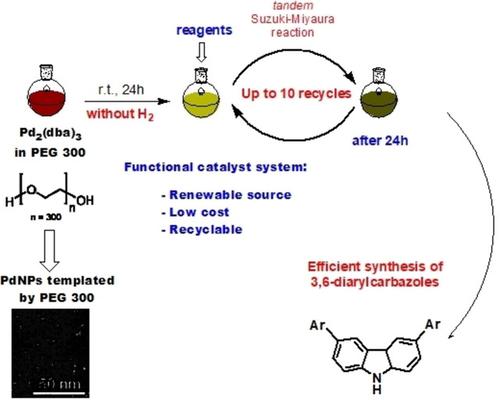当前位置:
X-MOL 学术
›
ChemistrySelect
›
论文详情
Our official English website, www.x-mol.net, welcomes your
feedback! (Note: you will need to create a separate account there.)
Revealing Pd Nanoparticles Formation from PEG‐Mediated Decomposition of Organometallic Precursor and Their Application as Catalyst for the Synthesis of n‐Extended Carbazoles.
ChemistrySelect ( IF 1.9 ) Pub Date : 2018-09-06 , DOI: 10.1002/slct.201801874 Matheus S. Arvelos 1 , Aires C. Silva 2 , Andrea L. F. de Souza 3 , Carlos A. Achete 4 , Thiago L. Vasconcelos 4 , Eveline Robertis 4 , Braulio S. Archanjo 4 , Lucia C. S. Aguiar 5 , Luiz Fernando B. Malta 5 , Jaqueline D. Senra 1
ChemistrySelect ( IF 1.9 ) Pub Date : 2018-09-06 , DOI: 10.1002/slct.201801874 Matheus S. Arvelos 1 , Aires C. Silva 2 , Andrea L. F. de Souza 3 , Carlos A. Achete 4 , Thiago L. Vasconcelos 4 , Eveline Robertis 4 , Braulio S. Archanjo 4 , Lucia C. S. Aguiar 5 , Luiz Fernando B. Malta 5 , Jaqueline D. Senra 1
Affiliation

|
Synthesis of well‐controlled palladium nanoparticles (PdNPs) by spontaneous decomposition of tris(dibenzylideneacetone)dipalladium(0) in polyethylene glycol Mw 300 (PEG 300) in the absence of reductant atmosphere or thermal effect is reported. The Pd nanoparticles exhibited a spherical pattern with 2‐ to 4‐nm diameter and low standard deviation according to scanning transmission electron microscopy (STEM) analysis. UV‐vis electronic spectroscopy, dynamic light scattering (DLS) and diffusion ordered spectroscopy (DOSY) mode of 1H nuclear magnetic resonance (NMR) suggested that PEG acts as a template for the formation of PdNPs. These nanoparticles were efficient towards the Suzuki‐Miyaura reaction for the synthesis of 3,6‐diaryl carbazoles. Indeed, the whole catalyst system demonstrated an efficient recyclability (ten consecutive runs) without significant interference of the N−H moiety. Since diaryl carbazoles are the core of a number of compounds contained within components of organic solar cells and photovoltaics, this method should allow additional organic materials substrates under relatively inexpensive catalytic conditions.
中文翻译:

揭示PEG介导的有机金属前体分解中Pd纳米颗粒的形成及其在合成n扩展咔唑的催化剂中的应用。
据报道,在不存在还原剂气氛或热效应的情况下,通过在聚乙二醇Mw 300(PEG 300)中自发分解三(二亚苄基丙酮)二钯(0)来合成可控的钯纳米粒子(PdNP)。根据扫描透射电子显微镜(STEM)分析,Pd纳米颗粒表现出球形图案,直径为2至4 nm,标准偏差低。紫外可见电子光谱,动态光散射(DLS)和扩散有序光谱(DOSY)模式为1H核磁共振(NMR)表明PEG充当PdNPs形成的模板。这些纳米粒子对Suzuki-Miyaura反应可有效合成3,6-二芳基咔唑。的确,整个催化剂体系表现出有效的可回收性(连续运行十次),而对NH部分没有明显的干扰。由于二芳基咔唑是有机太阳能电池和光伏组件中所含许多化合物的核心,因此该方法应允许在相对便宜的催化条件下使用其他有机材料作为基材。
更新日期:2018-09-06
中文翻译:

揭示PEG介导的有机金属前体分解中Pd纳米颗粒的形成及其在合成n扩展咔唑的催化剂中的应用。
据报道,在不存在还原剂气氛或热效应的情况下,通过在聚乙二醇Mw 300(PEG 300)中自发分解三(二亚苄基丙酮)二钯(0)来合成可控的钯纳米粒子(PdNP)。根据扫描透射电子显微镜(STEM)分析,Pd纳米颗粒表现出球形图案,直径为2至4 nm,标准偏差低。紫外可见电子光谱,动态光散射(DLS)和扩散有序光谱(DOSY)模式为1H核磁共振(NMR)表明PEG充当PdNPs形成的模板。这些纳米粒子对Suzuki-Miyaura反应可有效合成3,6-二芳基咔唑。的确,整个催化剂体系表现出有效的可回收性(连续运行十次),而对NH部分没有明显的干扰。由于二芳基咔唑是有机太阳能电池和光伏组件中所含许多化合物的核心,因此该方法应允许在相对便宜的催化条件下使用其他有机材料作为基材。











































 京公网安备 11010802027423号
京公网安备 11010802027423号